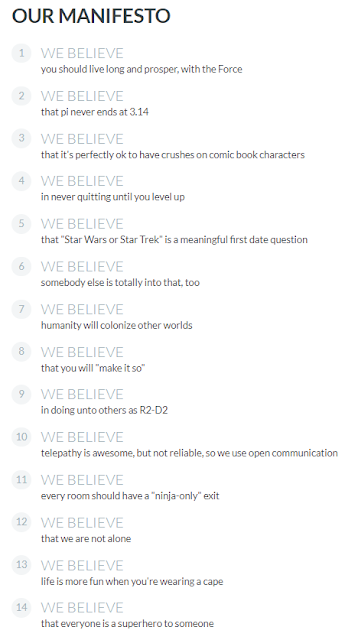I'm Thinking... ThinkGeek
ThinkGeek
 |
| (Geeknet, Inc., 2018) |
Geeks are notoriously collectors and ThinkGeek is the go-to website for all geeky collector items. ThinkGeek prides itself
“with creating and sharing unique and authentic product experiences that
stimulate fans’ imaginations and fuel their geek core” (Geeknet, Inc., 2018).
The online retailer is perfect for the geeky collector
because they feature items not only by product type, but by fandom or interest
– no matter how geeky or not the consumer is. The items on the site appeal to
all geeky people, not just one age group or gender. The fandoms or interests
range from cats to Star Wars to Tolkien and even to journaling, while the range
of items is even greater. You name it and it’s probably on ThinkGeek:
figurines, underwear, tools, games, office supplies, and much, much more (Geeknet,
Inc., 2018)!
But, how does one find ThinkGeek in the big world of the
internet? There are several sites dedicated to selling geeky collectibles and
vanity items, but ThinkGeek stands out among them. Why is that? Part of the
reason is that ThinkGeek is unique in what items it sells and in its geekily
relatable voice. A lot of online retailers focus on trying to sell the product
rather than telling you about in a way you understand. ThinkGeek specializes in
relating to and conversing with its consumers in their own language. The other
reason is simple and, of course, the focus of the blog: web analytics and SEO.
Web Analytics
ThinkGeek focuses on the consumer relationships over anything
else. To understand the consumers to create this relationship, ThinkGeek needed
to gather data on the consumers, how they maneuvered through the site, and what
they bought. In turn this allowed ThinkGeek to do a few things. The brand could
give each consumer a personalize experience when they visited the site. This also
gave ThinkGeek a chance to segment the audience and find understand the segments
in depth. Ultimately, this led the geek retailer to use geo-targeting to bring traffic
to the site because they saw how different the geek interests were between cities
and regions (Cameron, 2014).
Keyword Optimization
ThinkGeek also takes advantage of on-page SEO to draw
customers to the site. Do you know of any geek fandoms? Try Googling the fandom
and an item, for example: “star wars desk lamp” or “dungeons & dragons
shirt”. There’s a good chance a link to ThinkGeek was on the first page of your
search. There’s also a good chance your keywords were in the page title and the
meta/product description of the ThinkGeek product.
ThinkGeek D&D Shirts:
Competing D&D Shirts:
Which shirt would you buy? I’d buy the one that sounds fun
and is described with nerdy lingo. Product descriptions are one part of the SEO
game that ThinkGeek has down to a science. ThinkGeek is known for giving its
products long descriptions that include all the right words but aren’t too
forceful. The descriptions are also in line with the brand voice and words
consumers use (Karr, 2017). Each product on the ThinkGeek website has at least
two paragraphs describing the product and that’s not including any product
specifications or specific details about the item itself (Geeknet, Inc., 2018).
While it may seem that product descriptions are just product
descriptions, they aren’t. Product descriptions are a key part in attracting
visitors to your site. You want to use find the perfect balance between using
positive wording, describing the products, and keywords. Too little or too many
keywords in your product description and the consumer will opt to visit another
site (Mercer, 2015).
URL Optimization?
Keywords aren’t only for titles and descriptions. Adding
keywords to your site’s URL is one of the many ways to make your URL SEO-ready.
For as well as ThinkGeek handles keywords within other parts of the site, I was
surprised to see that keywords aren’t located in the site’s product URLs. Giving
URLs a similar description to the page title is another common factor in SEO
ready sites (Fishkin, 2015).
What ThinkGeek does have are short URLs. Where most sites
have a basic product description in the URL, ThinkGeek keeps it short and
sweet. Each product URL is typically in the format of www.thinkgeek.com/product/XXXX/,
replacing the “XXXX” with a four number/digit code where each product has a
unique code (Geeknet, Inc., 2018).
We know that, as consumers, it’s easy to read and we feel
safer clicking on URLs that are short, legible, and still descriptive. I think
ThinkGeek could benefit from adding another descriptive word or words to the
product URL and still keep the four-digit product identifier. For example, if
the product is related to Harry Potter, the URL could read www.thinkgeek.com/product/harrypotter/XXXX.
With the addition of Harry Potter to the URL, consumers know at least which
fandom the product is from even if they don’t know the fandom.
References
Cameron, N. (2014, April 3). CMO interview: ThinkGeek CMO on
customer analytics and cross-company relationships. CMO. Retrieved from https://www.cmo.com.au/article/542040/cmo_interview_thinkgeek_cmo_customer_analytics_cross-company_relationships/
Fishkin, R. (2015, February 24). 15 SEO best practices for
structing URLs. Moz. Retrieved from https://moz.com/blog/15-seo-best-practices-for-structuring-urls
Geeknet, Inc. (2018). ThinkGeek. Retrieved from https://www.thinkgeek.com/
Karr, D. (2017, September 13). What ecommerce business
owners need to know about shopify SEO. MarTech.
Retrieved from https://martech.zone/shopify-ecommerce-seo/
Mercer, M. (2015, September 11). How to write product
descriptions that will make customers love your brand. Moz. Retrieved from https://moz.com/blog/how-to-write-product-descriptions-thatll-make-customers-love-your-brand



Comments
Post a Comment